More than half a century ago the Rev. Martin Luther King Jr. led the march from Selma to Montgomery, a pivotal moment in the campaign for civil rights. Today, a visit to Montgomery is once again something close to a moral imperative, although one that rewards with a pair of new institutions that manage a unique combination of intellectual, visceral and aesthetic power.
These conjoined entities are the Legacy Museum and the National Memorial for Peace and Justice, the latter more commonly identified as a memorial to the victims of lynching. They are both extraordinary, though it is the second that behooves a pilgrimage. To my mind, it is the single greatest work of American architecture of the 21st century, and the most successful memorial design since the 1982 debut of Maya Lin's Vietnam Veterans Memorial in Washington, D.C.
Here, too, abstraction, repetition, typography and procession are mobilized to produce an experience that is at once revelatory and heartbreaking.
To my mind, it is the single greatest work of American architecture of the 21st century. — Mark Lamster

The museum and memorial are the public face of the Equal Justice Initiative, a Montgomery-based nonprofit that confronts racial discrimination in the legal system. Their design is a collaboration between that institution and another nonprofit, Boston-based MASS Design Group, an architecture and design firm founded in 2008 with the mantra "justice is beauty" and the express purpose of advancing human dignity.
If you ask representatives of EJI or MASS exactly who was responsible for the design, you will not get much of a response, which serves the interests of both parties: for EJI, it keeps the focus on the subject matter; for MASS, it reflects a welcome mode of architectural practice, one that emphasizes teamwork over individual genius.
The two projects, above all, were shaped by brutal facts. The design process effectively began with an EJI investigation, initiated in 2010, that documented more than 4,400 lynchings between 1877 and 1950, an increase of more than 800 over previous records.
It is one thing to read statistics; the memorial's strength resides in its ability to translate those numbers into a devastating physical experience.
That process begins at the gatehouse to the 6-acre memorial site, a liminal passage, almost a tunnel, that ushers visitors into the sacred space of the enclosed compound. On a wall of wooden slats is a quotation from King that neatly sums up the vision and principle of the entire project: "True peace is not merely the absence of tension. It is the presence of justice."
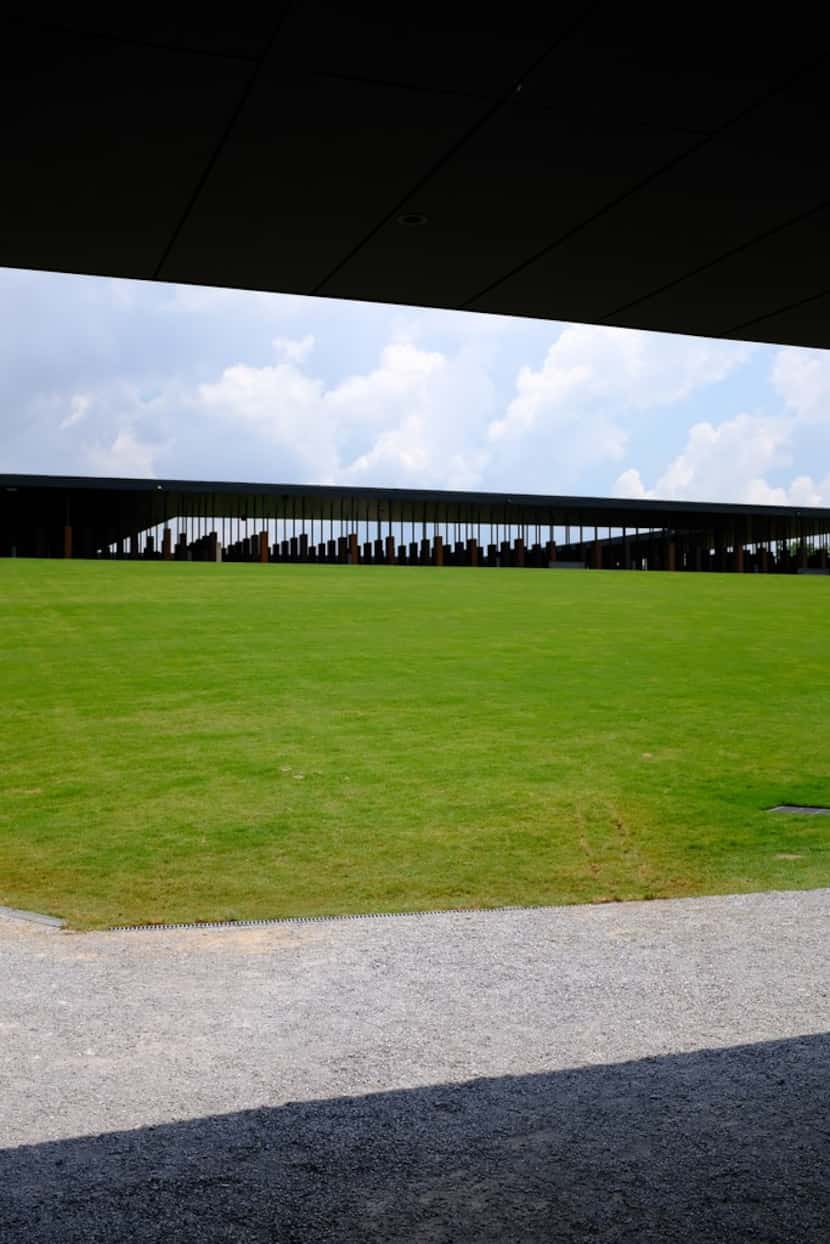
It is then that one has the first view of the memorial proper. It sits atop a grassy knoll, which takes on the contours of an ancient burial mound. It is a long and low rectangular structure, open to the sky at the sides and center, with rows of hanging blocks suspended from a charcoal black roof. The feeling is funereal and archaic; sublime in the way that the Romantics used that word, meaning not just beautiful, although it is, but possessed of a sense of fearsome awe.
The route up is not direct: it begins running parallel along a rough concrete wall that is slate gray and marked periodically by explanatory texts in metal type. A life-size figurative sculpture of an enslaved family in chains, by the West African artist Kwame Akoto-Bamfo, establishes the backdrop to the history of lynching.
The path switches back, and rises gently to the memorial itself, where the forms of the structure fully and clearly resolve themselves. The squared galleries spiral gradually down, with staggered grids of rust-colored corten steel monuments above. There are 800 of them, each 6 feet tall, and mounted to the ceiling by metal rods such that they sway almost imperceptibly in the breezes that pass through the open structure.
They are abstractions, of course, but in their proportions and their suspension the reference is unmistakable: They look, obviously and crushingly, like hanging bodies, like the lynched men and women and children whom they represent.
It is a solemn rite to walk among them, along plank floors with the sky — a bit of natural reprieve —peeking into the galleries. The number of monuments is dizzying, but even in their quantity they only begin to suggest the scale of the crime they document. Each monument represents not just one individual, but a county in which a lynching took place, meaning many honor more than one victim. They are arranged by state. The Dallas block is inscribed with two names: William Taylor murdered on Sept. 12, 1884, and Holland Brooks, who was lynched on March 3, 1910 in a public spectacle in the heart of downtown.
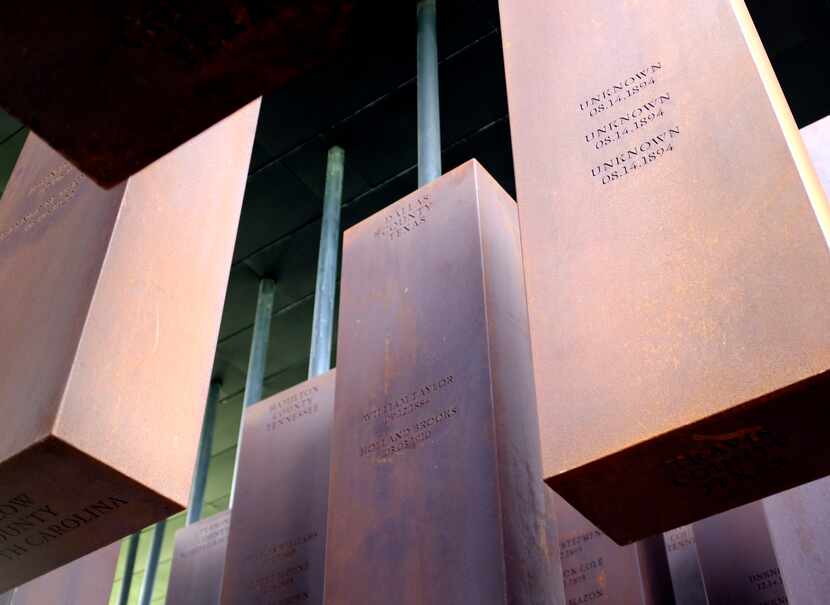
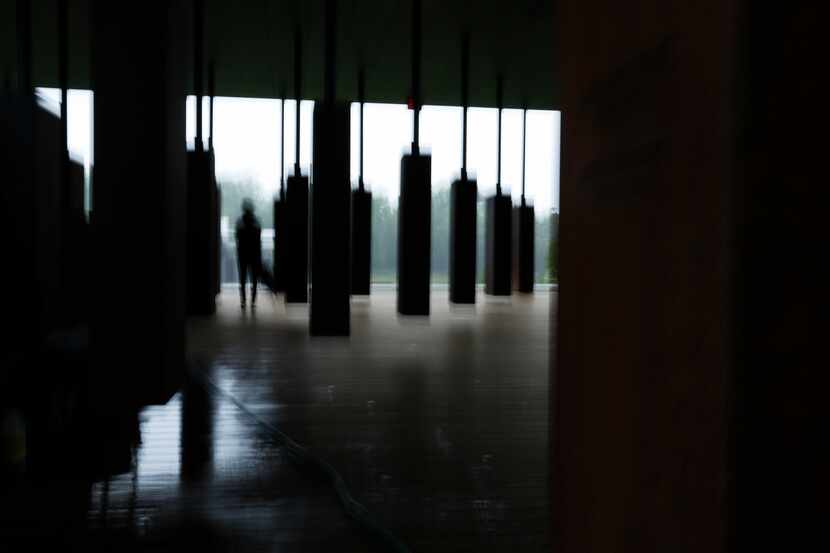
Yet even this can not account for the extent of the lynching terror, a fact reflected on the closing wall of the memorial, in which cascading water runs over type that reads: "Thousands of African Americans were victims of racial terror lynchings whose deaths cannot be documented, many whose names will never be known. They are all honored here."
As one circumnavigates the galleries, plaques on the concrete walls call out some of the names of the lynched, and the justifications for their murder: talking disrespectfully, organizing sharecroppers, kissing a white woman's hand, voting.
The memorial does not end as one exits its galleries to journey back down to the gatehouse. To its credit, it has no "end," the point being that until King's introductory injunction is realized and the full injustice of the lynchings and the continuing legacy of white supremacy is recognized and reversed, true peace is a mirage.
To that point, as one circles down the path from the galleries, moving now around the rear side of the memorial, one is led through and around rows of the corten-steel monuments, here lying on the ground. Each is an exact facsimile of one of those hanging within the memorial itself. The goal is that each of these should be taken back to the county it represents, and there given a place of honor, effectively extending the memorial to sites of injustice around the nation.
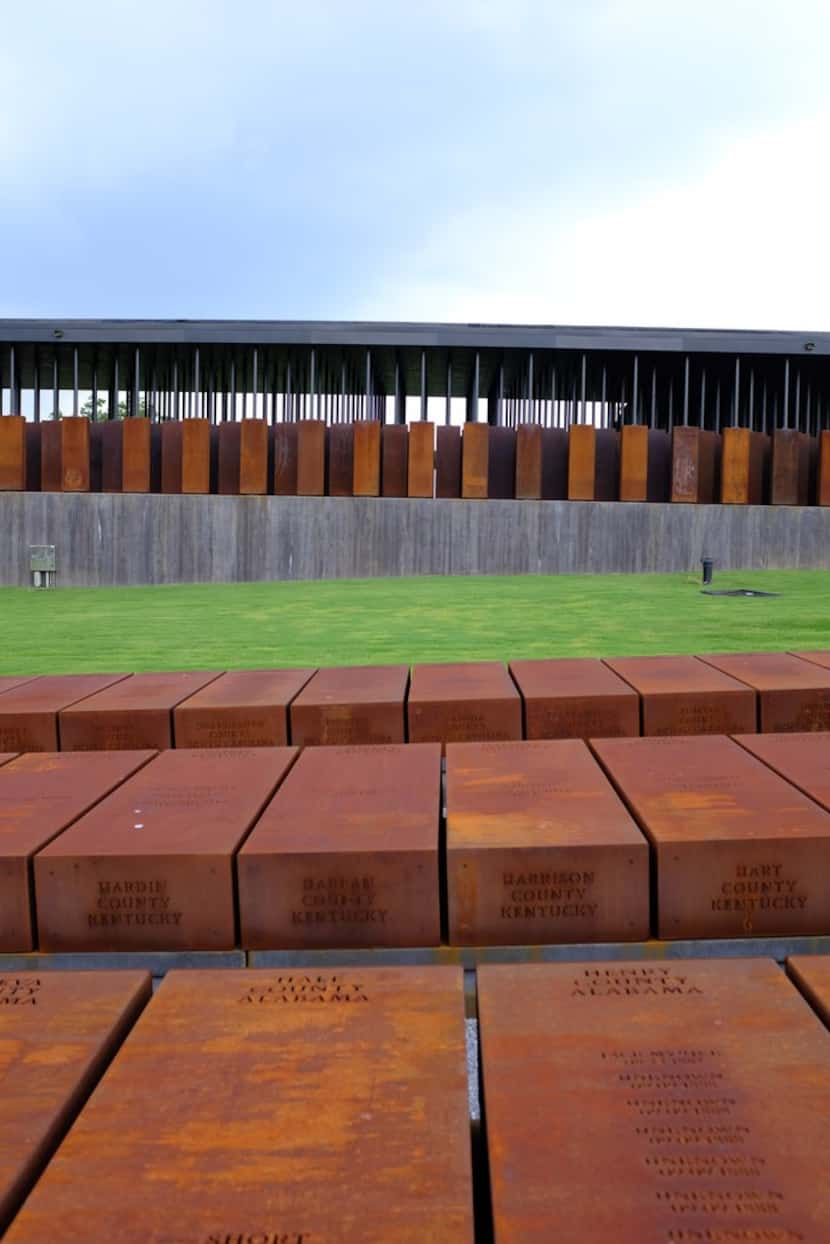
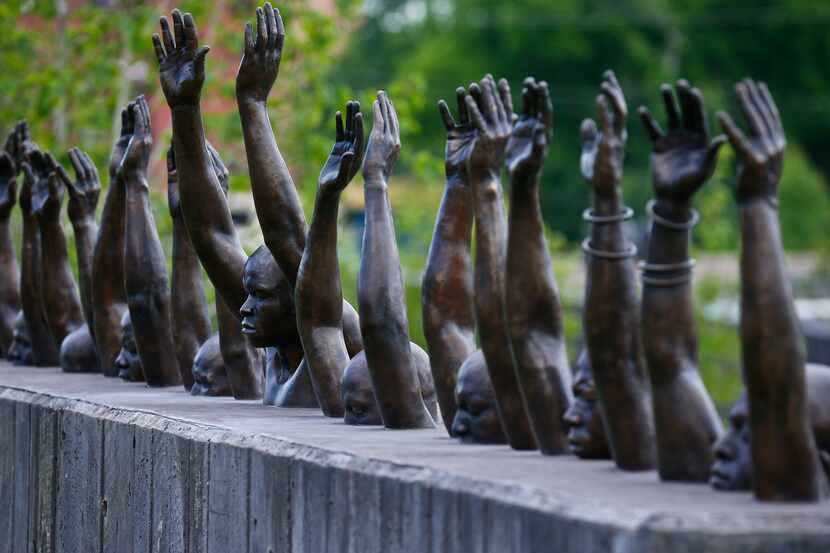
That is a noble and necessary mission, and one that is especially important in a city like Dallas, which in its shiny modernity and aversion to preservation, has eradicated so many of the markers of its past. If you're looking for a sign of ante- or postbellum building here, you will not have much luck.
That is not the case in a place like Montgomery, where the architecture of white supremacy is both ubiquitous and exceedingly white. Stately Greek revival mansions with broad columned porches are commonplace. One is a mere block from the memorial site; another, the Murphy House, an 1851 landmark built for a slave-trader, is just round the corner from the Legacy Museum.
Your introduction to that institution, which is a short walk from the memorial, is a blunt statement of this heritage. "You are standing on a site where enslaved people were warehoused."
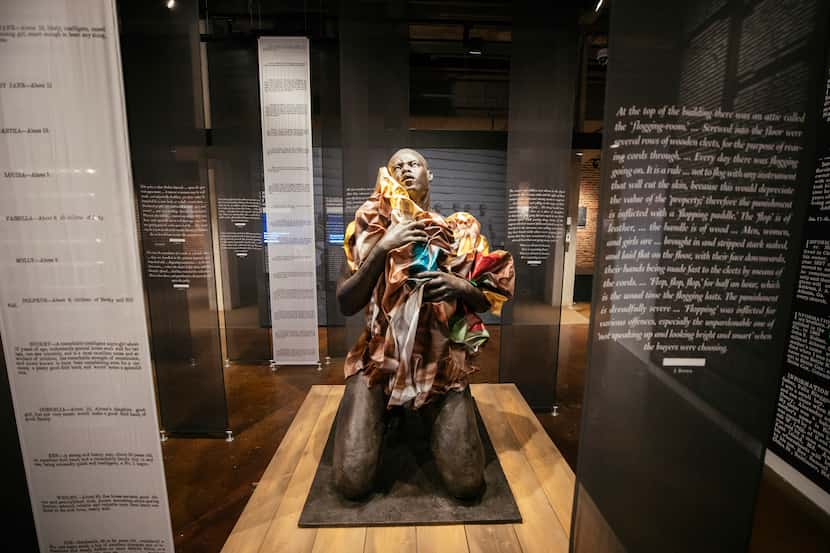
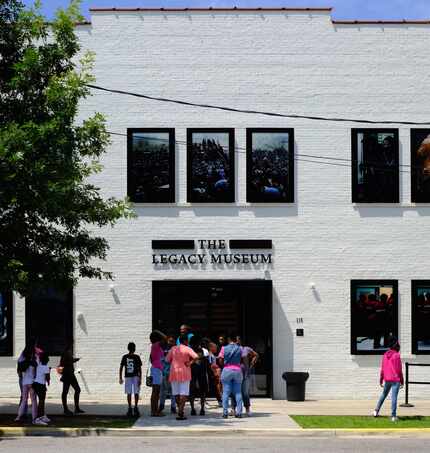
One of the first exhibits at the museum suggests the extent of architectural complicity. It is a description of the lots in an 1854 auction catalog of "negroes and mule" to be sold in Montgomery by the industrialist John Gano Winter. "The most manageable lot of hands that were ever before offered to the public." Among them was a 13-year-old, Affe Jane: "Likely, intelligent, raised to the field, promising girl, smart enough to learn anything."
It was Winter's banker son Joseph who built the appealing and still-standing commercial building on the city's main street, Dexter Avenue, from which the telegraph message authorizing the attack on Fort Sumter was sent, initiating the Civil War. The text of that missive had come from another historic building that is now just a short walk up that thoroughfare, the so-called First White House of the Confederacy. (Yes, it's white.)
So too is the Alabama state capitol building, a magisterial edifice that commands a view down Dexter from its elevated perch on high ground. It is worth a visit, if nothing else, to see the interior of its dome. But the fact is also inescapable, as noted at the Legacy Museum, that it has been and remains a locus of white supremacy. Indeed, the Alabama Constitution still requires separate schools for blacks and whites, and that "no child of either race shall be permitted to attend a school of the other race." That clause is no longer enforceable, at least for the moment, due to the Supreme Court's Brown vs. Board of Education ruling, but it remains on the books.

The Capitol has offered a bit of protection, if accidentally, to what has heretofore been Montgomery's central civil rights attraction, the Dexter Avenue Baptist Church, at which King was a pastor from 1954 to 1960. It is still an active congregation, though exceedingly friendly guides will be happy to tour you through its spaces, including King's basement office, which remains intact as a wood-paneled shrine.
The church sits in the shadow of the Capitol Building, and parishioners and historians believe it is that proximity to state authority — however unfriendly — that safeguarded the building from the terrorist attacks so often inflicted on southern black churches.
Today, the church backs up on another protector, the fortlike modern headquarters of the Southern Poverty Law Center, the nonprofit known for tracking hate groups. The metal-clad building, by the Philadelphia firm Erdy McHenry Architecture, is stolid, and itself is adjacent to that institution's own civil rights memorial, a Maya Lin designed black stone fountain inscribed with the names of civil rights figures.
It is not a long walk from there, down past King's old church to Court Square, which sits opposite the Capitol at the foot of Dexter Avenue. It is a traffic circle now, with a handsome beaux-arts fountain, but it has not always been so peaceful or bucolic. It was here that Montgomery's notorious slave auctions were held. Winter's handsome merchant building with its telegraph station was just across the street.
But the square has also marked crucial moments of the civil rights movement. It was here that Rosa Parks boarded the bus on which she would refuse to give up her seat in 1955. And a decade later, in 1965, it was through here that King led the marchers for voting rights on their long walk from Selma following the Bloody Sunday clash.
The Legacy Museum and Memorial for Peace and Justice tell us we still have a long road to travel for racial equity. In Montgomery, we can find a map for that journey.
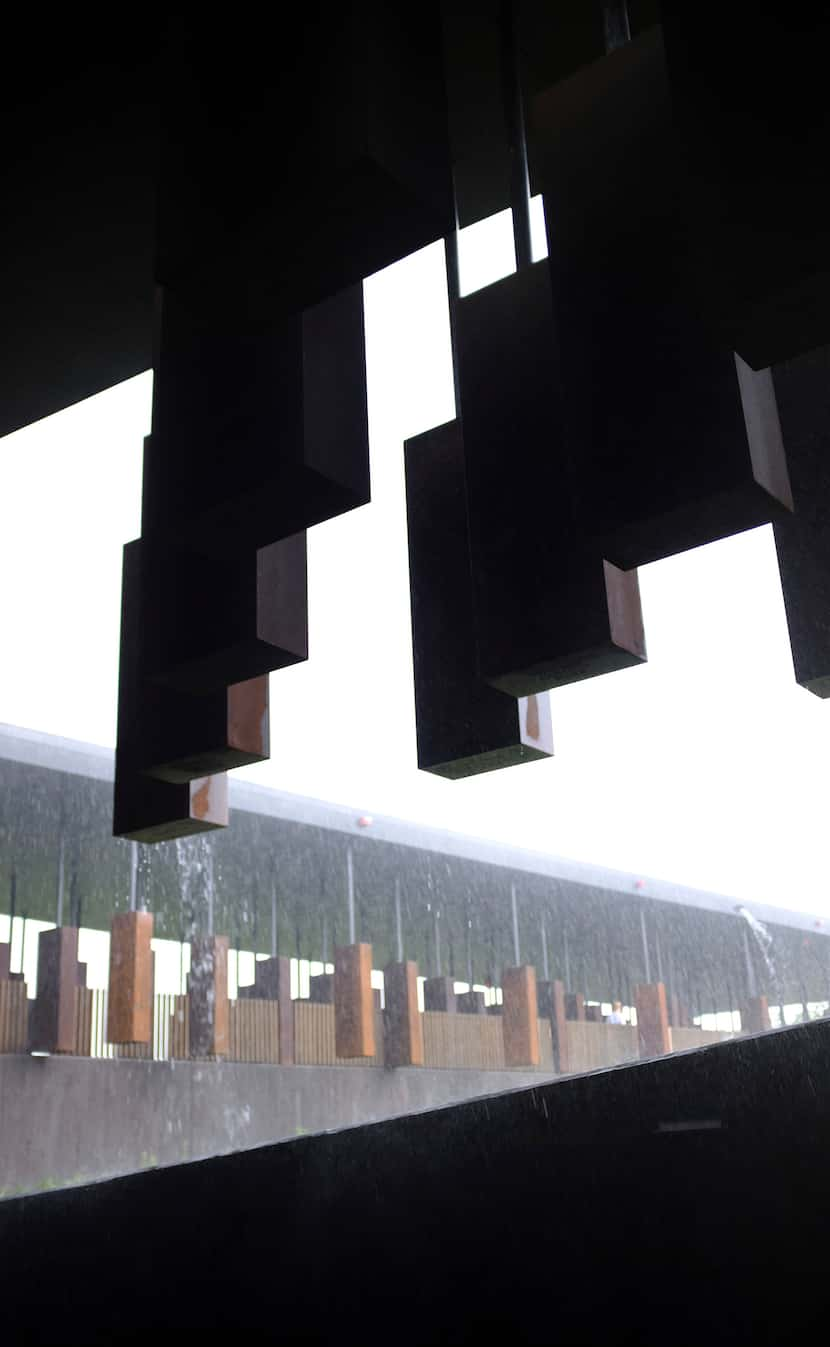
Mark Lamster is the architecture critic of The Dallas Morning News, a Loeb Fellow at the Harvard Graduate School of Design and a professor at the University of Texas at Arlington School of Architecture.
Details
Legacy Museum: 115 Coosa St., Montgomery, Ala. Admission: $8 adult, $5 students and seniors
National Museum for Peace and Justice: 417 Caroline St., Montgomery, Ala. Admission: $5Combined tickets are available for $10 adults, $7 seniors and students. Reserve at museumandmemorial.eji.org.

/cloudfront-us-east-1.images.arcpublishing.com/dmn/F5S2YSWWSFDL5ETVPWMAR4IIMM.jpg)
/cloudfront-us-east-1.images.arcpublishing.com/dmn/XVPEQJX4SRGT7OSHUVAKN5FFGQ.jpg)
:no_upscale()/cloudfront-us-east-1.images.arcpublishing.com/dmn/FVNFZF773ZGBBIMFHTQJFFNT2Y.jpg)
/cloudfront-us-east-1.images.arcpublishing.com/dmn/D4FJ726DTR6SREKVO4SCKYKNEE.jpg)
/cloudfront-us-east-1.images.arcpublishing.com/dmn/VVGIMAHWGFF2BPST7A36S4AYJY.jpg)